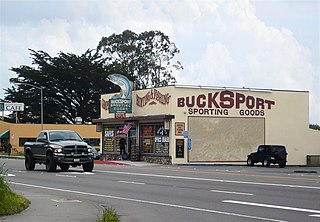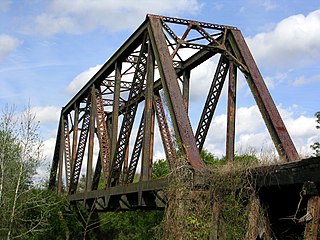Related Research Articles
The Ocklawaha Valley Railroad, originally the Ocala Northern Railroad, was a railroad running from Silver Springs Junction, Florida to Palatka, Florida, running roughly parallel to the Oklawaha River. Except for the southernmost part, from Silver Springs Junction to Silver Springs, which was leased from the Seaboard Air Line Railroad, the railroad never had any corporate relationship with larger railroad companies.
The California Western Railroad, popularly called the Skunk Train, is a freight and heritage railroad in Mendocino County, California, United States, running from the railroad's headquarters in the coastal town of Fort Bragg to the interchange with the Northwestern Pacific Railroad at Willits.

The Sumpter Valley Railway, or Sumpter Valley Railroad, is a 3 ft narrow gauge heritage railroad located in Baker County, in the U.S. state of Oregon. Built on a right-of-way used by the original railway of the same name, it carries excursion trains on a roughly 5-mile (8.0 km) route between McEwen and Sumpter. The railroad has two steam locomotives and several other pieces of rolling stock. Passenger excursion trains operate on weekends and holidays from Memorial Day through the end of September.

The Diamond and Caldor Railway was a common carrier 3 ft narrow gauge railroad operating in El Dorado County, California, in the United States. The 34-mile railroad was primarily a logging railroad but also did some passenger service.

The McCloud Railway was a class III railroad operated around Mount Shasta, California. It began operations on July 1, 1992 when it took over operations from the McCloud River Railroad. The MCR was incorporated on April 21, 1992.

The Arcata and Mad River Railroad, founded in 1854, was the oldest working railroad in California. It operated on a unique narrow gauge until the 1940s when standard gauge rails were laid. Service ceased in 1983 due to landslides. It is California Historical Landmark #842.

The Aberdeen and Rockfish Railroad is a short-line railroad operating in North Carolina. At one time the AR was a Class 2 railroad. The railroad has 47 miles (76 km) of track that runs from Aberdeen to Fayetteville, North Carolina.
Pickens Railway is a shortline railroad that has operated on two separate divisions in the Upstate Region of South Carolina:
San Francisco and Northwestern Railway (SF&NW) was an Atchison, Topeka and Santa Fe Railway subsidiary formed in 1903 to connect Humboldt Bay to the Santa Fe rail system.

The Bodie & Benton Railway was a 3 ft narrow gauge common carrier railroad in California, from the Mono Mills to a terminus in Bodie, now a ghost town, in Mono County. It was unusual among U.S. railroads in that it was completely isolated from the rest of the railroad system.

A forest railway, forest tram, timber line, logging railway or logging railroad is a mode of railway transport which is used for forestry tasks, primarily the transportation of felled logs to sawmills or railway stations.

Pino Grande is an unincorporated community in El Dorado County, California. It is located 8 miles (13 km) north-northwest of Pollock Pines, at an elevation of 4022 feet.

Bucksport was a town in Humboldt County, California. The original location was 2.5 miles (4 km) southwest of downtown Eureka, on Humboldt Bay about 5 miles (8 km) northeast of entrance. at an elevation of 16 feet (4.9 m). Prior to American settlement a Wiyot village named Kucuwalik stood here.
The Greenbrier, Cheat and Elk Railroad (GC&E) was a logging railroad in West Virginia operating in the early 20th century. Its main line ran from Bergoo to Cheat Junction, where it connected with the Western Maryland Railway (WM).
The East Waterford Lumber Company was an early 20th-century company which leased and harvested timberland in Juniata and Perry County, Pennsylvania.
The Caspar, South Fork & Eastern Railroad provided transportation for the Caspar Lumber Company in Mendocino County, California. The railroad operated the first steam locomotive on the coast of Mendocino County in 1875. Caspar Lumber Company lands became Jackson Demonstration State Forest in 1955, named for Caspar Lumber Company founder, Jacob Green Jackson.

Willow is a ghost town in Manatee County, Florida, United States.
The Atlantic and Danville Railway was a Class I railroad which operated in Virginia and North Carolina. The company was founded in 1882 and opened its mainline between Portsmouth, Virginia and Danville, Virginia in 1890. The Southern Railway leased the company from 1899–1949. The Norfolk and Western Railway purchased the company in 1962 and reorganized it as the Norfolk, Franklin and Danville Railway.
Mendocino Lumber Company operated a sawmill on Big River near the town of Mendocino, California. The sawmill began operation in 1853 as the Redwood Lumber Manufacturing Company, and changed ownership several times before cutting its final logs in 1938. The sawmill site became part of the Big River Unit of Mendocino Headlands State Park where a few features of the mill and its associated forest railway are still visible along the longest undeveloped estuary in northern California.
References
| This United States rail–related article is a stub. You can help Wikipedia by expanding it. |